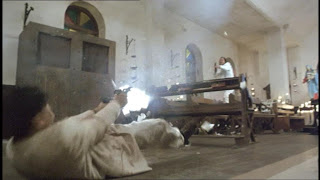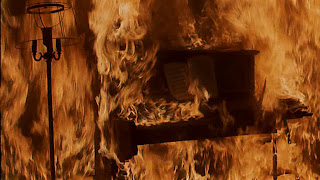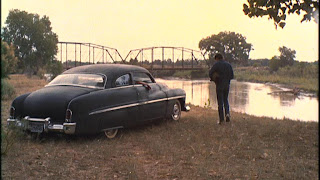 Ostensibly, the ingredients of John Woo’s seminal “heroic bloodshed” opus ‘The Killer’ make it sound like a cinematic cocktail (or, more appropriately, a cinematic Molotov cocktail):
Ostensibly, the ingredients of John Woo’s seminal “heroic bloodshed” opus ‘The Killer’ make it sound like a cinematic cocktail (or, more appropriately, a cinematic Molotov cocktail):Take one existentially iconic hitman a la Jean-Pierre Melville, a dash of Sirkian melodrama (preferably the ‘Magnificent Obsession’ vintage), a double measure of visual imagery from early Scorsese, and a liberal helping of Peckinpahesque slo-mo. Add white doves. Blend.
Which would constitute a pretty accurate and unprecedentedly short (65 word) review, the only addition to which would be a handful of kick-ass screen shots, were it not for the fact that Woo transcends every borrowing, every homage, every lovingly crafted frame of reference and creates something that is stylistically and emotionally his own.
Or, to put it another way, Woo does what very few other directors have ever done with such a degree of success (I can think only of Tarantino offhand): he synthesises his influences so completely that while the end product is beholden on virtually every level – narratively, aesthetically, everything else that ends in “–ly” – to a plethora of other, earlier works, it nonetheless pulls together these diverse strands in a manner that either goes beyond or in a completely different direction to those selfsame influences.
 In ‘Le Samourai’, Melville doesn’t have Alain Delon cauterize an exit wound by tamping gunpowder over it and applying a lighted cigarette. In ‘The Wild Bunch’, Peckinpah doesn’t stage the bunch’s climactic shoot-out with Mapache’s army against a backdrop of religious imagery, flickering candles and white doves. And, yes, Melville and Peckinpah don’t make these aesthetic choices for a reason. But Woo does. And that’s kind of the point in and of itself.
In ‘Le Samourai’, Melville doesn’t have Alain Delon cauterize an exit wound by tamping gunpowder over it and applying a lighted cigarette. In ‘The Wild Bunch’, Peckinpah doesn’t stage the bunch’s climactic shoot-out with Mapache’s army against a backdrop of religious imagery, flickering candles and white doves. And, yes, Melville and Peckinpah don’t make these aesthetic choices for a reason. But Woo does. And that’s kind of the point in and of itself.The simplest (and least critically valid) summation is that Woo doesn’t certain things – particularly with regard to his use of slow motion, freeze frames and dissolves – because they fucking look cool as fuck. Which they do. And if you can shoot an action scene that’s as balletic, iconic, dynamic and hyper-kinetic as a John Woo action scene, then screw it, you’ve earned the right to do that kind of thing for its own sake and to hell with anything deeper like thematic content, characterisation and moral imperatives.
Woo, however, does things not just because they fucking look cool as fuck but because they contribute to the thematic content of his work, because they define and develop the characterisation, and because he is concerned with the moral imperatives of honour, guilt and redemption. Then, and only then, does the fact that they fucking look cool as fuck come into play.



 Let’s revisit that phrase “moral imperative”. Sometimes it’s the directors whose work appears most violent, or attracts the most controversy, who prove themselves as having the more demonstrable morality: it’s true of Sam Peckinpah, true of Michael Haneke, true of John Woo. Haneke’s approach is one of cool, detached cerebralism; his aesthetic rigidly formalist. Woo, like Peckinpah, is a more emotionally involved filmmaker. He is acutely conscious of the way men interact and the codes that bind or divide them. He understands the mindset of the outcast, the criminal, the (conventionally speaking) bad guy. He sees the wounded and compromised humanity in them. Sometimes it’s a defeated sense of humanity; sometimes it’s retrievable.
Let’s revisit that phrase “moral imperative”. Sometimes it’s the directors whose work appears most violent, or attracts the most controversy, who prove themselves as having the more demonstrable morality: it’s true of Sam Peckinpah, true of Michael Haneke, true of John Woo. Haneke’s approach is one of cool, detached cerebralism; his aesthetic rigidly formalist. Woo, like Peckinpah, is a more emotionally involved filmmaker. He is acutely conscious of the way men interact and the codes that bind or divide them. He understands the mindset of the outcast, the criminal, the (conventionally speaking) bad guy. He sees the wounded and compromised humanity in them. Sometimes it’s a defeated sense of humanity; sometimes it’s retrievable.  ‘The Killer’ is about a thoughtful and ultra-professional hitman, Ah Jong (Chow Yun Fat) who accidentally blinds nightclub singer Jenny (Sally Yeh) during a hit that turns into a fully-fledged gun battle. During the aftermath, rather than go to ground, he undertakes the proverbial one last job in order to raise money for the cornea transplant that could restore Jenny’s sight, despite the fact that maverick cop Inspector Ying (Danny Lee) is on his trail and unaware that his former paymasters are about to double cross him.
‘The Killer’ is about a thoughtful and ultra-professional hitman, Ah Jong (Chow Yun Fat) who accidentally blinds nightclub singer Jenny (Sally Yeh) during a hit that turns into a fully-fledged gun battle. During the aftermath, rather than go to ground, he undertakes the proverbial one last job in order to raise money for the cornea transplant that could restore Jenny’s sight, despite the fact that maverick cop Inspector Ying (Danny Lee) is on his trail and unaware that his former paymasters are about to double cross him.It sounds generic, clichéd and predictable. In Woo’s hands, it’s a dementedly excessive but savagely beautiful and often ludicrously funny work of art.












































